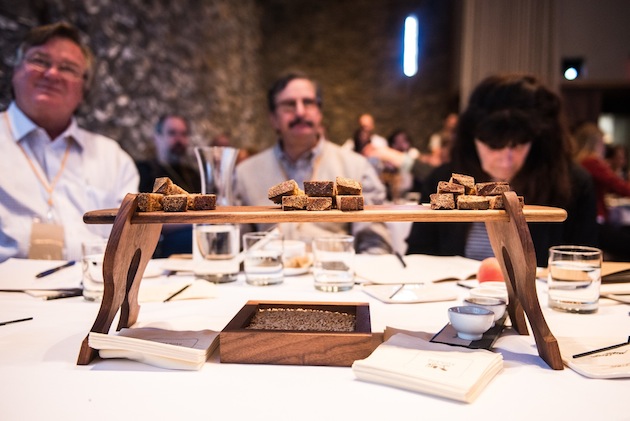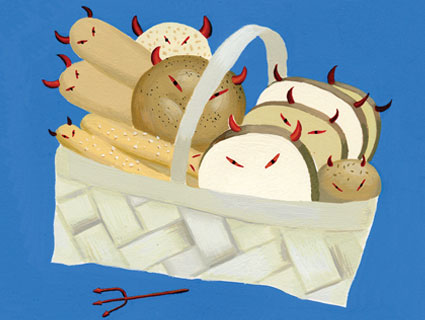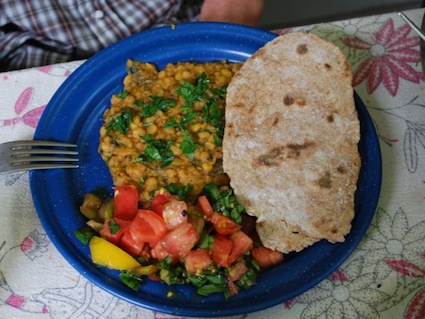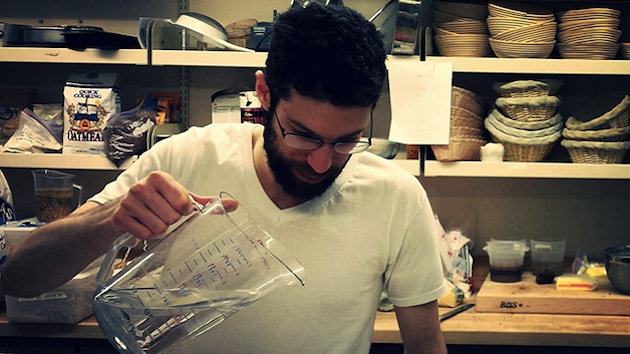
The artisan as scientist: baker Jonathan McDowell in the Bread LabPhotos: Tom Philpott
Washington State University’s agriculture research and extension facility in Mount Vernon, about an hour due north along the Puget Sound from Seattle, looks at first glance like any recently built academic edifice: that is to say, boring and austere. On the outside, it’s surrounded by test plots of wheat and other grains, as well as greenhouses, shrouded in the Pacific Northwest’s classic gray skies and mist. Inside, professors and grad students shuffle through the long halls, passing quiet offices and labs.
Yet one of those labs is not like the others—or any other that I know of, for that matter. When you look down the length of the room from the back wall, you see two distinct chambers, separated by long, adjoining tables: gleaming chunks of impressive-looking machinery to the left; flour sacks, mixing bowls, a large, multileveled oven to the right. And in place of the vaguely chemical smell of most university labs, you get the rich, toasty aroma of fresh-baked bread.
Mounted on the outer edge of the short wall that divides the two tables, there’s an image of a human brain, with its two halves. “Aha, that symbolizes the lab,” says lab staffer Jonathan McDowell. The left side is the “analytical laboratory, where raw objective data is generated by high-tech machinery,” he says, gesturing to a contraption that measures the protein level in flour. The right side, meanwhile, is the “intuitive laboratory of the artisan baker, where hands and palate are the means of validation.” Taken together, the Bread Lab is like a “unified mind, where science and art coalescence,” he says.
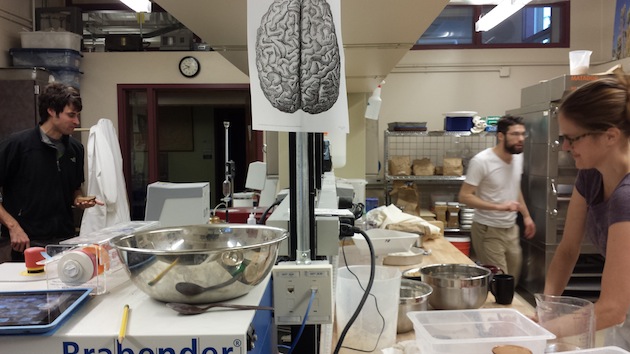
McDowell is a slender, bespectacled, slightly flour-dusted young man in red trousers, black loafers, and V-necked white T-shirt, his face framed by a thick beard and mop of close-cropped dark hair. He looks like he’d fit in better onstage at an indie rock show than at an ag research center in a rural county. Yet he couldn’t be more at home. McDowell is the staff baker here at the Bread Lab, the brainchild of Washington State wheat breeder Stephen Jones, who’s also the director of the Mount Vernon research outpost. Jones believes fervently that grain breeding—the art and science of creating new varieties—has been hijacked by large seed, milling, and baking interests, giving rise to high-yielding but boring varieties geared to the mass production of crappy, and mostly white, bread.
For the last half-century or so, says Jones, wheat has been bred for industrial mills, where it is ground and separated into its three components: flour, germ, and bran. Usually, the flour gets turned into white bread, while the germ and bran—which contain all of wheat’s healthy fats and fiber, and much of the vitamins—go to other uses, including supplements and livestock feed. In most of what we now know as “whole wheat” bread, some—but not all—of the bran and germ are mixed back in.
For Jones, these are inferior products—both in nutrition and taste terms. So he has been working with farmers in the Pacific Northwest to develop wheat varieties that can be milled into flour that’s suitable for being baked directly into bread. And it falls to McDowell—who took over the role of the lab’s baker from Jones himself last year—to show the world that 100 percent whole-wheat bread isn’t just edible, but delicious.
According to Jones and McDowell, low-quality industrial white flours and fast-rising commercial yeasts, along with additives like vital wheat gluten—a wheat product added to give bread structure despite superfast rises—have generated a backlash against bread in the form of the “gluten-free” craze. While people with celiac disease genuinely can’t process the gluten in wheat, they argue, most people actually can. The problem is that most industrial bakeries only allow bread to rise for a matter of minutes—not nearly long enough to let the yeast and bacteria digest all the gluten in the flour, let alone the extra dose in the additives. The result can lead to all kinds of problems in our gut.
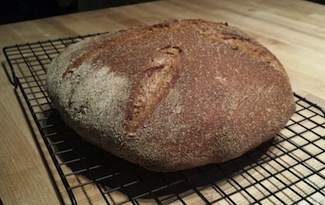
McDowell gets philosophical when you ask him about the rise (so to speak) of “gluten-free bread.” In a quiet corner of the lab, he ruminates on the topic. “What has been the staff of life is now perceived as the spirit of disease,” he says. “Symbolically, you can look at bread as a representation of our society through history,” he says. “If you look at gluten as what holds bread together, and you look at bread as what holds our society together, what is ‘gluten-free bread,’ then? Is it not a symbol of our times?” McDowell calls the rush away from bread as it’s commonly made now a “wake-up call” and “opportunity” for bakers to reestablish bread as a healthy, delicious staple. And he sounds genuinely undaunted by the project of doing just that.
Moreover, McDowell and Jones say, wheat that has been bred to be made into white flour doesn’t make very interesting bread—and can be downright unpalatable when people try to make it into a whole wheat loaf. That’s why 100 percent whole-wheat bread has a reputation for being good-for-you but kind of awful—cardboard-flavored and overly chewy. For that reason, even whole-foods enthusiasts like me tend to use at least half white flour when we bake.
The quixotic goals of the Bread Lab, in short, are to rescue bread from gluten-villain status, while simultaneously pushing whole wheat from the hippie margin to the delicious center of the culinary world. (Jones and McDowell aren’t alone in this of course—the food writer Mark Bittman has been experimenting with 100 percent whole wheat as well, as have others.)
I tasted McDowell’s bread at an event last fall—and again during my January trip to the Bread Lab—so I knew he could make spectacular 100 percent whole-wheat bread from a sourdough starter. My question was: Could I do it, under his tutelage, in my home kitchen? I’m a pretty rudimentary home baker. Before this experiment, I had made exactly one 100 percent whole wheat bread loaf before. It didn’t make for very good eating, but could have enjoyed a long career as a garden steppingstone. Nor had I ever successfully baked with sourdough—my one previous effort had failed to rise, and I suspected I had murdered my starter before it ever got a chance to feed on the flour I was offering it.
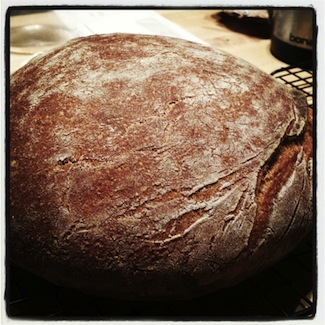
Before I ended my visit, McDowell insisted on gifting me a small plastic vial of his own special starter (to satisfy the liquid-suspicious Transportation Security Administration gods, he made it into a nearly solid paste by adding lots of flour). He also handed me a bag of freshly ground whole-wheat flour; and a recipe, that he scribbled out on the spot, on lined, yellow paper. I had told him that my most successful previous foray into bread baking had been with the “no-knead” recipe popularized by New York baker Jim Lahey and immortalized for all time by Bittman.
The Lahey/Bittman loaf calls for a dough leavened with a tiny amount of commercial yeast, which is left to rise overnight and then cooked in a tightly covered pot in a blazing-hot oven. McDowell adapted his recipe along those lines.
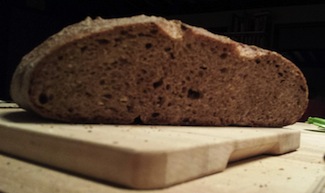
I’m happy to report that, under McDowell’s direction, I have churned out two fantastic loaves. They had a faint sourness that added a dimension of flavor without being at all shrill or dominant. In the first loaf, I had become paranoid that I had fouled up the process of waking up the sourdough starter. But the bread was delicious—nutty and moist inside with plenty of air pockets, surrounded by a thick, hearty crust—”as good as bread gets,” a bread-savvy friend visiting from Chicago declared. The second one, after I had lavishly fed and cared for the starter, was outstanding, too, but seemed a little denser than the first. Go figure. Living creatures—humans and microbiota alike—are capricious. Here’s Jonathon’s recipe—a perfect thing to try on a rainy or snowy day at home. (It takes six or seven hours, very little of it active, from start to finish, once you get the starter prepped.)
Whole-Wheat Sourdough Bread
Equipment/flour note: This recipe requires a dutch oven—a heavy-duty pot with a tight-fitting lid—because these durable pots capture the steam from the dough to create the thick, blistered crusts you typically only can get from commercial baking ovens. (Dutch ovens can get quite expensive, but for bread-making purposes, my favorite is the relatively affordable cast-iron type.) Also, a cheap digital kitchen scale isn’t absolutely necessary for this recipe—McDowell kindly converted gram weights to cups and tablespoons—but will make the work go a lot more smoothly. Also, please be sure to read the whole recipe before you get started; it requires a few days of planning. As for flour, obviously everyone doesn’t have access (yet) to fresh-ground wheat that’s been carefully bred specifically for whole-grain bread. But mid-sized operations like North Carolina’s Lindley Mills and California’s Community Grains are working with farmers in their regions to produce top-quality whole wheat bread flour products, and are worth seeking out. McDowell says that some Whole Foods outlets offer Community Grains flour ground at the store—a definite win if you can get your hands on it. If you can’t find a regional product, King Arthur’s organic 100 percent whole wheat flour is available nationwide and should “give you decent results,” McDowell says.
First, make or acquire a starter:
“Most artisan bakers would be happy to give you a piece of their levain to inoculate your own starter with,” McDowell says. But he recommends trying to start one from scratch. McDowell says that homemade starters primarily utilize the yeast and bacteria present in the flour itself, but that over time, they acclimate to their particular environment. “Not every location can easily start or sustain one,” he warns, but most can. Here’s how:
3 tablespoons whole rye or wheat flour
Enough water to make what looks like a “thick pancake batter.”
Stir to mix and let it sit out, loosely covered, for 24 hours. Then take 60 grams (1/4 cup) of the starter, discarding the rest, and mix it with 60 grams of water (1/4 cup) and 60 grams (3/8 cup) of flour. Repeat this process every 12 hours for 3 to 5 days. By the time it’s obviously alive—slightly bubbly and smelling distinctly acidic—you’ll have succeeded in creating a levain. You can jump straight to step (b) in the section below with this the new starter and bake with it; or store in the refrigerator until you’re ready to bake.
Next, prepare your culture for baking:
When you’re ready to bake, start 24 hours ahead if you’re using a refrigerated starter. You’ll need to wake it up and get it ready to leaven a loaf.
a) Mix 60 grams flour (3/8 cup), 60 grams warm water (about a quarter cup), 30 grams starter (about 1/8 cup) in a small bowl. Let sit at room temperature (70 degrees F) for 12 to 14 hours.
b) Then, take 10 grams (about a tablespoon) of that starter (you can discard the rest), which will have begun to get lively, and mix it with 60 grams flour (about a half cup) and 60 grams water (about a quarter cup).
Let it sit for 12 to 14 more hours. Now you’ll have just enough lively starter for a loaf—a little more than a half cup—plus a bit left over to begin the next batch of starter.
Now, get that next batch going: Scoop out about 10 grams (1/8 cup) of the starter, and add 20 grams of flour (1 1/3 tablespoons) and 20 grams of water (1 1/3 tablespoons). Mix it, and let sit for 3 hours at room temperature, then store in the fridge, covered tightly. Keep it alive by baking every week; or feed it once a week by scooping out 10 grams (1/8 cup) of starter (discarding the rest), and mixing with 20 grams of flour (1 1/3 tablespoons) and 20 grams of water (1 1/3 tablespoons), as above.
Now, finally, make the bread:
Ingredients
580 grams (4 cups) whole wheat flour
506 grams (2¼ cups) water, at room temperature
12 grams (2½ teaspoons) salt
120 grams (½ cup) Starter
Step 1: This is known as the autolyse step. Mix the starter and water together in a large bowl or plastic bread-making tub (see video below—I used a bowl). Add the flour, and mix well. Let sit 20 to 40 minutes.
Step 2: Mix dough by hand, squeezing and folding it to develop gluten. Here’s how.
Step 3: Let it rest, covered, for 3 hours, periodically folding as above (3 to 4 times).
Step 4: Shape the dough into a round by gently folding it over on itself, leaving a smooth, round top and a seamed bottom. This is known as a boule. Let it rest, covered, 20 minutes.
Step 5: Very gently place the boule, seam side up, into a floured proofing basket for 1.5 to 2 hours. If you do not have a proofing basket, you can take a linen (or fine mesh cotton, but linen is best) cloth, rub plenty of flour into it and place it in a small mixing bowl. Make sure there is ample flour covering all surfaces that the dough will touch, and also be sure that the bowl is deep enough to really shore up the sides of the boule. (I used a bowl-shaped metal colander as my proofing bowl, lined with a well-floured cloth.) About an hour into the proof, preheat the oven to 500 degrees and put the empty Dutch oven, with cover, into the oven, so that it will become blazing hot.
Step 6: Very carefully, drop the boule into the hot Dutch oven, seam side down.
Step 6: Make a few incisions along the top membrane about ¼ inch into the dough’s surface, to help with the loaf expansion. McDowell uses a straight razor. I used a serrated (bread) knife. (I forgot to do this in my second loaf.)
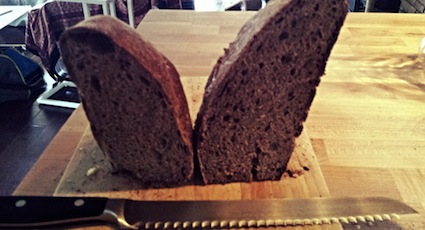
Step 7: Bake approximately 30 minutes , then remove the lid of the Dutch oven and bake until the boule is a deep brown—10 to 15 minutes more. (You can insert an instant-read thermometer into the loaf—when done, it will be within a few degrees of 212 degrees F).
Step 8: Let cool on a metal rack—at least one hour; 4-6 hours is optimal to let the loaf develop flavor.

